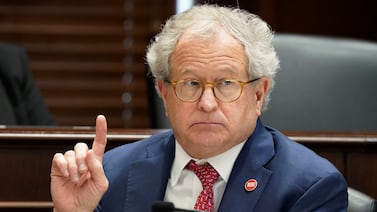Sign up for Chalkbeat New York’s free daily newsletter to get essential news about NYC’s public schools delivered to your inbox.
Over the past week, families of preschoolers got offers to New York City’s sprawling free early childhood education system — and acceptance rate data shared Tuesday by city officials contains a familiar paradox.
Even as the city faces a historic child care affordability crisis, tens of thousands of free seats will likely go vacant once again next school year. Roughly 56,000 students turning 4 by the end of 2025 got offers last week to the city’s pre-K program, which has capacity for roughly 70,000, according to data shared Tuesday by Education Department officials with the City Council. Another 44,000 students turning 3 this year got offers Tuesday for 3-K, which has room for 47,000.
Across the roughly 130,000 total early childhood education seats overseen by the city’s Education Department, only about 70% are currently filled, according to Simone Hawkins, the deputy chancellor for Early Childhood Education.
Officials, advocates and lawmakers point to a number of potential reasons, including a lack of outreach, a drop in the population of young kids, and a mismatch between the location of seats and demand.
“We have to really face the reality that this sector is very much stressed and strained for a variety of reasons,” said Hawkins, who took over as deputy chancellor last July after her predecessor’s rocky two-and-a-half-year tenure. “I do think that outreach is part of the solution. It’s not the whole solution. It’s a matter of really moving seats closer to where the demand lives.”
Despite all those empty seats, thousands of families didn’t get into any of their preferred programs, officials said. Roughly 15% of 3-K applicants, more than 6,000 students, didn’t get into any of the programs they listed on their application and were instead assigned other options by the city — leaving some facing long commutes.
Rebecca Bailin, the executive director of New Yorkers United for Childcare, said her organization has already heard from multiple families concerned that their 3-K offer is too far away or has hours that don’t work.
One family living near the border of Bushwick and Ridgewood was placed in a program roughly 40 minutes away and not easily accessible by train, according to survey results shared with Chalkbeat.
“I can’t get there every morning with a 3 year old, it’s just not feasible,” wrote the parent, who said they would likely have to continue paying for a private program.
City officials noted that this year, unlike last, every family at least got an offer. Some families might get into programs off waitlists over the summer, officials added. And while families can apply for up to 12 programs, about half of the families applying to preschool rank only one or two programs, according to a report commissioned several years ago by the Education Department.
Zachary Nosanchuk, a spokesperson for Mayor Eric Adams, said the mayor’s recent commitment to long-term funding for 3-K is allowing the city for the first time to offer “a seat in 3-K for every child and family who wants one.” City officials will “continue to work with families to ensure every child can attend a program that meets their needs,” he added.
Officials have for years pointed to a misalignment between where seats are located and where there’s demand but have yet to make a major dent in fixing the problem. The rate of filled 3-K seats varies widely across the city — from a low of 61% in District 23 in central Brooklyn to a high of 98% in District 30 in western Queens, according to a recent report from the Independent Budget Office.
Hawkins said the department is constrained by the contracts that govern the city’s relationship with scores of community-based organizations who operate the lion’s share of the 3-K and pre-K programs. She said the city is doing its best to work within those contracts to shift seats to better align with demand, including converting pre-K seats into 3-K seats and shifting seats currently earmarked as full-year seats only for low-income families to school year seats for any family.
In addition, city officials are seeking to shift more of their federally-funded Head Start seats to 0- to 2-year-olds because of growing demand for that age range, they said.
Factors including the cost of housing and the COVID-19 pandemic have also contributed to a shrinking number of young kids in the five boroughs. The population of kids under 5 in New York City shrank by 18% between 2020 and 2023.
But many advocates and lawmakers say the city still has a long way to go in making families who are here aware of the program and how to apply.
“We’ve talked to parents … who didn’t even know about 3-K,” said Bailin. And even though Adams committed to long-term funding to sustain 3-K in this year’s budget, Bailin argued that years of budget uncertainty has hampered the city’s ability to effectively administer the program.
Adams agreed to add $5 million to the fiscal year 2025 budget specifically for outreach, and included the funding again for this year, but not beyond that. It’s one of several education items council members are fighting to get long-term funding for.
Hawkins agreed with suggestions from several council members that the Education Department should embark on a more wholesale reimagining of the early childhood education system.
“It’s not just about opening new seats … it’s not just about the age of seats, but the type of seats and the people who are supporting these children through their learning trajectory,” she said.
Michael Elsen-Rooney is a reporter for Chalkbeat New York, covering NYC public schools. Contact Michael at melsen-rooney@chalkbeat.org





